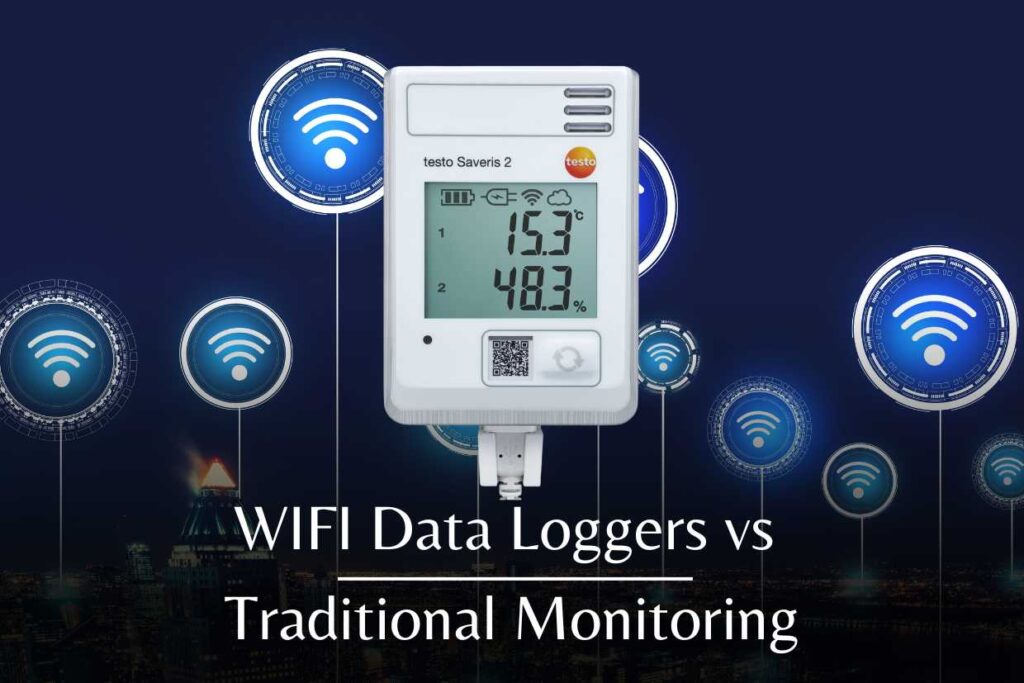We’ve all been there – you must monitor critical environmental conditions like a facility’s temperature, humidity, or pressure. However, stretching cables, wiring sensors, and finding accessible power sources proves challenging. Collecting field data requires hiking to remote areas and manually recording readings. Once contained, data must be transcribed and analysed – an inefficient and error-prone process. There has to be a better way, right?
Enter Wi-Fi data loggers – the innovative wireless solution taking monitoring and data collection into the 21st century. In this article, we’ll compare traditional monitoring methods vs modern Wi-Fi data loggers. Read on to learn why wireless wins every time.
The Limitations of Traditional Monitoring.
First, let’s consider traditional monitoring techniques. Wired sensors are a standard method, requiring cables stretching across facilities to connect sensors to central data loggers. Installation can be expensive and disruptive, with bulky conduits and wiring eating up time and budgets. Wired systems also lack flexibility – expanding monitoring means running additional cabling.
Manual data collection is another traditional technique. Think of the classic scenario of recording temperatures on a clipboard or reading gauges in the field. This manual process could be faster and more efficient and introduces potential for human error. Data is only as good as the diligence of the person collecting it.
Latency is another downside. Data must be transcribed and analysed after manual collection, causing delays. There’s also minimal remote access and oversight – you can only monitor conditions by being physically present. This dramatically inhibits data visibility and responsiveness.
Traditional techniques like wired sensors and manual collection also need to scale better. Adding more monitoring points requires increasingly complex infrastructure and labour. Costs and management needs balloon as systems expand.
In summary, the significant limitations of traditional monitoring are
- High upfront costs for installation and instrumentation
- Inflexibility and lack of scalability
- Latency due to manual data collection/transcription
- Limited oversight and data visibility
- Frequent maintenance and tech support needs
The Trailblazing Benefits of WIFI Data Loggers.

Now, let’s explore the game-changing advantages of Wi-Fi data loggers. These battery-powered devices contain onboard sensors and wireless transmission capabilities.
Installation is quick and easy – data loggers mount via screws or magnets in minutes with no wiring required. Units can be flexibly moved as monitoring needs change. Scaling to more measurement points is also a breeze – deploy additional loggers. The only limit is your number of loggers and Wi-Fi coverage.
Wi-Fi connectivity enables real-time data transmission. Loggers wirelessly send readings to cloud databases where data can be accessed remotely on any internet-connected device. This means no more manual reading and transcription. Data is available instantaneously from anywhere. Now, personnel can respond to environmental threats immediately rather than waiting for lagged reports.
Location flexibility is another significant advantage. Wi-Fi data loggers work equally well indoors and outdoors with wide operating temperature ranges. Units can monitor remote areas where wiring sensors is impractical or impossible. Say goodbye to inconvenient field data collection.
Advanced Wi-Fi data loggers have sophisticated capabilities like displaying real-time conditions locally on bright LED screens, generating SMS or email alerts for threshold violations, and running complex control logic. Some even have built-in relay outputs to automate system responses.
Cost savings are substantial compared to wired systems – reduced infrastructure and labour add up. And with no manual reading needed, you can monitor more points with less staff. Maintenance is also minimised without cables, conduit, and field tech support.
Wi-Fi data loggers empower more thoughtful decision-making with insights previously inaccessible. Instant environmental visibility enables early problem detection, predictive maintenance, model validation, and data-driven process optimisation.
WIFI data loggers and their applications
To appreciate the power of Wi-Fi data loggers, let’s look at real-world examples.
Smart agriculture.
Loggers with soil moisture and temperature sensors enable remote monitoring of crops and greenhouses. Data guides watering schedules and environmental controls. Automated alerts notify farmers of any out-of-spec conditions.
HVAC optimisation.
Monitoring temperature and humidity wirelessly allows efficient HVAC management. Data identifies hot/cold spots, validates setpoints, and detects performance issues. This ensures comfort while maximising energy savings.
Food safety.
Perish the thought of food spoilage. Loggers ensure cold chain compliance, with instant alerts if temperatures exceed set limits—no more manually recording fridge or freezer temperatures. Automated reports document proper food handling.
Machine health.
Vibration data loggers mounted on equipment provide early warning of developing failures before catastrophic breakdowns occur. Monitoring overall equipment effectiveness is also simplified.
Asset tracking.
Dynamic loggers with GPS and accelerometers can track the location and condition of valuable assets like vehicles or containers. Geofencing and impact alerts add security and oversight.
Leak detection.
Water leak sensors deployed throughout a facility immediately notify if water is detected, allowing rapid response. Preventing water damage saves money and avoids disruptions.
Stormwater.
Loggers with ultrasonic sensors monitor water levels and flow rates in rivers, channels, and drainage systems. Data guides flood control efforts and infrastructure upgrades.
Compliance.
Wi-Fi loggers document proper environmental conditions and procedures. Get notifications immediately if parameters exceed legal limits or standard protocols. Demonstrate due diligence to regulators.
The applications are nearly endless. Wi-Fi data loggers make reliable, real-time monitoring possible in virtually any environment or industry. Their flexibility empowers new use cases rather than limiting them.
Comparison of Wi-Fi data loggers and traditional data loggers.

Let’s compare traditional monitoring side-by-side with Wi-Fi data loggers to drive home the differences.
| Feature | Traditional Monitoring | Wi-Fi Data Loggers |
|---|---|---|
| Cost | High upfront for infrastructure and instrumentation | Low upfront with reduced infrastructure |
| Flexibility | Low – adding points requires new wiring/cabling | High – loggers can be easily added or repositioned |
| Data Access | Manual reading and transcription causes latency | Real-time data access remotely via the internet |
| Analytics | Limited to manual review and simple spreadsheets | Robust analytics platforms provide insights |
| Maintenance | Frequent site visits and tech support are required | Low maintenance with wireless operation |
| Scalability | Low-expanding requires additional infrastructure | High – deploy more loggers with little added overhead |
| Remote Access | Requires in-person site visits | Monitor anywhere with internet connectivity |
| Ease of Use | Complex setup and management | Simple deployment and intuitive dashboards |
Alright, if you don’t like table comparisons, here is a summary of that table with a boxing match-type comparison to declare a winner. Ding ding!
Installation: Wireless loggers rope-a-doped wired sensors with simple, rapid deployment. Round one goes to Wi-Fi!
Flexibility: With repositionable loggers, wireless wins the manoeuvrability match hands down. Wi-Fi leads 2-0.
Data access: Cloud-based software KOs clipboard jottings for slow, limited data. Wi-Fi up 3-0!
Analytics: Robust Wi-Fi platforms crunch data into insights using cutting-edge tech. Traditional methods throw in the towel.
Scaling: Adding more wireless loggers is as easy as pie. Wired systems tap out when climbing complexity soars.
Just like that, it’s all over! Wireless tech completes the decimation, leaving old-school methods down for the count. Grab the defibrillators; we need to revive Traditional Monitoring!
By virtually every measure, Wi-Fi data loggers provide superior convenience, flexibility, visibility, analytics, and value compared to traditional monitoring methods.
With advantages across the board, innovative wireless solutions are here to stay. And exciting evolutions are coming.
Expect longer sensor battery life, expanding wireless range, and more innovative embedded analytics. There’s even talk of distributing intelligence across the logger network using edge computing. Foggy machine learning, anyone?
The knockout blows keep coming as wireless tech presses the pace of progress ever forward. Meanwhile, Old-School Monitoring is still nursing a nasty headache after eating Canvas. Maybe it’s time they waved the white flag and embraced the wireless takeover!
Driving Data-Centered Decisions.
Modern businesses and institutions run on data. Wi-Fi data loggers empower data-driven decision-making with cloud-based analytics platforms. Platforms unify data from multiple loggers into visual dashboards accessible anywhere.
Powerful features like custom reporting, data modelling, and exportable files simplify analysing trends and identifying anomalies. Configure automated alerts and notifications to receive instant flags for out-of-spec conditions. Integrate with building automation and control systems to trigger automatic responses.
Organisations gain unprecedented visibility into facilities, supply chains, infrastructure, and processes by making reliable environmental data readily available. This enables informed adjustments and optimisations. Issues are also caught early before cascading into major problems.
The Wireless Future is Here.

Across countless industries, It’s clear as a sunny day that wireless data loggers knock out outdated monitoring strategies. Wi-Fi data loggers are replacing ancient traditional methods. The benefits are clear. Instant data access from anywhere, quick and flexible deployment, superior scalability, and reduced labour.
Wireless monitoring offers tangible paybacks for facilities, supply chains, infrastructure, and more – expect adoption to accelerate. We’ve only scratched the surface of possibilities as monitoring technology continues evolving.
New frontiers like long-range networking, intelligent analytics, and smart actuators are coming. Imagine loggers that monitor across states while running artificial intelligence to optimise operations automatically. The future promises exciting developments!
It’s clear the age of manual monitoring and wired sensors is waning. Wireless data loggers are the obvious next step, like the transition from flip phones to smartphones. Their advantages over legacy methods are decisive and pronounced.
To start with Wi-Fi data loggers and revolutionise your monitoring capabilities, check out our website, request a custom quote, or contact us today to schedule a demo! The wireless future beckons; Will you answer its call? The time is now to unshackle yourself from outdated monitoring methods.





